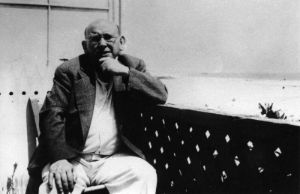Concert
Pellegrini-Quartett
Hanns Eisler in America

Hanns Eisler on the terrace of his house in Malibu Beach, 1945 © Archiv Dr. Jürgen Schebera
The Musikfest Berlin 2012 has not omitted to include the work of Hanns Eisler, on the occasion of the half-century of Eisler’s death. Together with the International Hanns Eisler Society (Internationale Hanns Eisler Gesellschaft), the Musikfest presents the composer’s American years, in contribution to the Hanns-Eisler Symposium (Hanns-Eisler Tagen) 2012.
Hanns Eisler’s years of exile resemble an odyssey: Vienna, New York, the Danish island of Funen, Strasbourg, Liberec in North Bohemia and Moscow were just some of the stations along his route of flight after 1933. In 1937, he fought for the Spanish Popular Front. In 1938, he returned to the USA on a six-month tourist visa as he had previously had. He then divided his time between visiting Mexico and living illegally in the USA until receiving his residence permit. Because of his political activism, Eisler was viewed with mistrust by the US authorities, and despite the protests of many prominent colleagues, he was expelled from the USA in 1948 for his communist sympathies.
Hanns Eisler’s Sonata for Violin and Piano (Sonate für Violine und Klavier), the “Reisesonate”, was composed in 1937 on the way from Spain to Prague. His string quartet was written in 1938 in New York. While teaching at the New School for Social Research in New York, Eisler conducted a research project on film music, together with Theodor W. Adorno. Within this framework, he sketched film music to the silent film Regen by the Dutch director Joris Ivens, out of which Eisler composed his work Fourteen Ways to Describe Rain (14 Arten, den Regen zu beschreiben).
Charles Ives’ Three-Page Sonata begins with the B-A-C-H-motif and contains several twelve-tone rows surrounded by ragtime and march structures. The two movements Largo risoluto No. 1 and No. 2 display notable polymetrical layerings, and No. 2 also includes highly effective dynamic differentiations between string quartet and piano.
With its elements of American folklore, Aaron Copland’s Sextet from the year 1937 anticipates the style of his later successes Billy the Kid, Rodeo and Appalachian Spring.
Composer Ruth Crawford Seeger from Ohio belonged to the American ‘ultra-modernists’, who rejected the classical European tradition. Crawford Seeger had contact with John Cage’s teacher Henry Cowell. Her works are freely tonal, strongly dissonant and precisely structured.
Together with soloists Andrea Kollé, Heinrich Mätzener and Christoph Keller, the Pellegrini Quartet, which has already recorded Eisler and Crawford Seeger’s quartets to critical acclaim, brings Hanns Eisler into exciting dialogue with his American colleagues.
www.pellegrini-quartett.de
www.andreakolle.com
www.christoph-keller.ch
Hanns Eisler [1898-1962]
Sonata for violin and piano “Reisesonate” [1938]
Charles Ives [1874-1954]
Three-Page Sonata [1910-11]
Charles Ives
Largo risoluto No. 1 and No. 2
for string quartet and piano [1908-09 and 1909-10]
Hanns Eisler
String Quartet [1938]
Aaron Copland [1900-1990]
Sextet
for clarinet, piano and string quartet [1938]
Ruth Crawford Seeger [1901-1953]
String Quartet [1931]
Hanns Eisler
14 Arten, den Regen zu beschreiben op.70
dedicated to Arnold Schönberg [1941]
Andrea Kollé flute
Heinrich Mätzener clarinet
Christoph Keller piano
Pellegrini-Quartett